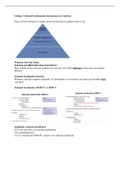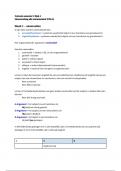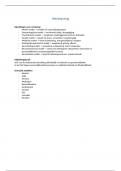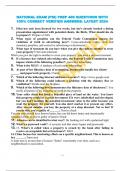Taak 1
Learning goals:
1. Does Andrew suffer from depression? What might be a differential diagnosis?
Current understanding of narcissism and narcisstic personality disorder
Jessica Yakeley.
I don’t think so, I think Andrew suffers from narcissistic personality disorder:
Narcisissm, narcissistic personality disorder and the DSM
– Grandiosity and self-importance
– Persistent fantasies of success, power, attractiveness, intellectual superiority or
ideal love
– Sense of superiority and specialness
– Wish to be admired
– Strong sense of entitlement
– Manipulates and exploits others
– Lack of empathy
– Believes others are envious of him/her and envy of others
– Arrogant and contemptuous attitudes and behaviours
2 subtypes:
- Grandiose/overt narcisme: arrogant, pretentious, dominant, self-assured,
exhibitionist or aggressive.
- Vulnerable/covert narcisme: overly sensitive, insecure, defensive and
anxious about an underlying sense of shame and inadequacy.
Rare narcisstic personality disorder.
Borderline of adjustment disorder with mild depressive symptoms.
Bipolar disorder.
2. How do I decide whether the questionnaire of choice is a good one? (How can
you be sure that the questionnaire is the right questionnaire for this
patient/setting/symptoms etc)
Psychological diagnostics in health care, fourth edition.
F. Luteijn & DPH Barelds 1973- & Debbie van Ballen-Trevor.
Before measuring:
The diagnostic process:
One way to regulate and discipline the diagnostic process is to structure it according to the
empirical cycle of scientific research.
This cycle is a model for answering questions in a scientifically justified manner. It consists of
observation, induction, deduction, testing and evaluation.
1. Observation involves collecting and classifying empirical materials, which provide the
basis for forming thoughts about the creation and persistence of problem behavior.
2. Induction includes the formulation of theory and hypotheses about the behavior.
3. During the deduction phase, testable predictions are derived from these hypotheses.
4. During the testing phase, new materials are used to determine whether the predictions
are correct or incorrect.
5. The aforementioned finally results in the evaluation.
,1.5 The diagnostic process: from the application to
the report
1.5.1 Application
Vraag vanuit verwijzer en cliënt is niet altijd hetzeflde.
Dus het eerste wat je wil is: analyzeren en
verduidelijken van de vraag → (1) informatie over
verwijzer en (2) details over het type en inhoud van de
vraag.
1.5.2 The diagnostic reflections
Elk deel informatie wordt gereflecteerd.
1.5.3 Diagnostic scenario
Omschrijven problematisch gedrag (theorie) cliënt aan de
hand van informatie verkregen uit voorgaande fases.
1.5.4 The diagnostic examination
1. Hypothesis formulation
Selection of tools is important in the diagnostic
process (deduction!).
The diagnostic process is the same as the empirical
cycle.
1.3 Five basic questions in clinical psychodiagnostics
5 basisvragen die basis vormen voor meeste vragen die cliënten, verwijzers en
diagnosticeurs stellen:
- Recognition: wat zijn de problemen; wat werkt en wat niet?
• Criterion-oriented measurement: vergelijken met standaard.
• Normative measurement: vergelijken met representatieve groep.
• Ipsative measurement: vergelijken met individu op eerder tijdstip.
• All-or-nothing principle: DSM → cliënt behoort in bepaalde groep.
• More-or-less principle: cliënt krijgt bepaalde score in bepaalt gebied.
- Explanation: waarom ontstaan bepaalde problemen en wat houdt deze in
stand?
• (1) Belangrijkste probleem en (2) condities die voorkomen probleem
beschrijven (3) causale relatie tussen 1 en 2.
• Locus; persoon of situatie: verklarende factor ligt in persoon zelf of
in de omgeving.
• Nature of control: is het probleem oorzakelijk of een reden.
• Synchronous and diachronous explanatory conditions:
synchronous valt samen met probleem en diachronous gaan vooraf
aan probleem.
• Induced and persistent conditions: induced geven aanleiding tot,
persistent houden probleem in stand.
- Prediction: hoe gaat het probleem van de cliënt zich in de toekomst
ontwikkelen?
- Indication: hoe kunnen de problemen opgelost worden?
• Knowledgde of treatments and therapists.
• Knowledge of the relative usefulness of treatments.
• Knowledge of the client’s acceptance of the indication.
- Evaluation: zijn de problemen adequaat opgelost aan de hand van een
bepaalde interventie?
,Meten in de praktijk. Stappenplan voor het gebruik van meetinstrumenten in de
gezondheidszorg. Beurskens, S., van Peppen, R., Stutterheim, E., Swinkels, R.,
Wittink, H.
Selection of measuring instruments in practice:
1. What do you want to measure?
Depends on goal of measuring:
-Diagnostic: What is the status of this patient in relation to the variable being
measured?
-Prognostic: Does this patient have an increased risk of developing chronicity or
delayed recovery?
-Evaluative: Has the treatment led to an improvement of the situation?
-Inventory: What information is needed to adapt the treatment to the individual
patient?
2. For what purpose do you want to measure?
You ask yourself why you want to measure something; so what purpose does
measuring have? (for example: you want to get a clear view of the patients problems,
you want to evaluate your own acting).
3. What type of outcome measure do you want to measure with?
Outcome measure = variable you want to quantify.
4. How do you find a measuring instrument?
You can search in a lot of sources; use the right searching terms and the right
sources (for example: google scholar, Cochrane, pubmed.)
5. What is the manageability?
Usable for the patient: readability, nature of the questions, test time and frequency
and physical and cognitive load.
Usable for the caregiver: experience, terms and conditions and interpretation.
6. What is the methodological quality?
Validity:
-Face-validity: does the measuring instrument seem good at first sight?
-Content-validity: does the measurement tool cover all relevant aspects?
-Criteriumvalidity: compare with gold standard.
-Constructvalidity: compare with other measuring instruments or compare between
groups by making hypotheses.
Repeatability: repeating measurements, same outcome.
-Inter-rater: more patients, one assessor.
-Intra-rater: one patient, more measurements moments.
Responsivity:
Is the measurement tool capable to measure changes.
Internal consistency:
In what extent do items correlate which each other.
7. How will you analyse the data?
Determine the level of measurement:
-Nominal: onderscheid (niet metrisch ongeordend categoriserend).
Bijv. kleur haar: blond, bruin, rood, zwart, grijs.
Dichotome variabelen: slechts 2 mogelijkheden.
Bijv. ja/nee. Goed/fout. Man/vrouw.
-Ordinal: ordering zonder vaste afstand (niet metrische geordend categoriserend)
Bijv. Geheel mee eens/mee eens/noch mee eens-noch mee oneens/mee
oneens/geheel mee oneens.
, -Interval/ratio: nulpunt en vaste afstand (metrische kwantificerend)
Bijv. aantal kinderen 0/1/2/3.
Bijv. zich wassen: aantal keren per week 0/1/2/3/4/5/6/7/>7x.
8. How will you interpret and report the data?
Give a short explanation of the measuring instrument and interpret the scores in
relation to the patient.
3. How do we interpret the BDI-scores
Psychological diagnostics in health care, fourth edition.
F. Luteijn & DPH Barelds 1973- & Debbie van Ballen-Trevor.
Interpreteren BDI:
Score optellen van de 21 items door de nummers op te tellen die je gegeven hebt (0, 1, 2, 3).
Hoogst mogelijke score is 36, dit betekent dat je bij alle vragen 3 hebt ingevuld. De laagst
mogelijke score is 0, dit betekent dat je overal 0 hebt ingevuld. Je kunt je depressie score
evalueren aan de hand van onderstaande tabel:
1-10 Deze ups en downs zijn normaal
11-16 Milde stemmingsstoornissen
17-20 Grensklinische depressie
21-30 Gemiddelde depressie
31-40 Ernstige depressie
Over 40 Extreme depressie
Sensitivity: percentage van de zieken die terecht een positieve testuitslag krijgen
(terecht ziek aangeduid).
Specificity: percentage van de niet-zieke personen die terecht als niet ziek worden
aangeduid.
➔ Vaak laag in psychologische testen.
How depressed is “depressed”? A systematic review and diagnostic meta-analysis of
optimal cut points for the Beck Depression Inventory revised (BDI-II). Michael von
Glischinski & Ruth von Brachel & Gerrit Hirschfeld.
A lot of different cut off points, but:
Psychiatric patients: 19. So if the score is over 19 that means they are depressed and if the
score is lower than 19 this means that they are in remission.
Healthy samples: 13. So if the score is over 13 that means they are depressed and if the
score is lower than 13 this means that they are in remission.
This indicates that higher cut-off points for interpretation of BDI scores in psychiatric
patients (compared to somatic and healthy people) are necessary to maximise
diagnostic usefulness of the BDI test.
4. Why do we (clinical psychology) need tests?
Psychological testing and psychological assessment: A review of evidence and
issues. Gregory J. Meyer & Stephen E. Finn & Lorraine D. Eyde & Gary G. Kay & Kevin
L. Moreland & Robert R. Dies & Elena J. Eisman & Tom W. Kubiszyn & Geoffrey M.
Reed.
Psychological testing: straightforward process where a particular scale is used to obtain a
specific score.
Purpose of testing for various clinical purposes:
- Description of clinical symptoms and differential diagnosis.
- Description and prediction of functional capacities in everyday behaviour.
- Prediction of later functioning and differential treatment needs for medical and mental
health conditions.
- Monitoring treatment over time.
- Use psychological testing as a treatment in itself.
Learning goals:
1. Does Andrew suffer from depression? What might be a differential diagnosis?
Current understanding of narcissism and narcisstic personality disorder
Jessica Yakeley.
I don’t think so, I think Andrew suffers from narcissistic personality disorder:
Narcisissm, narcissistic personality disorder and the DSM
– Grandiosity and self-importance
– Persistent fantasies of success, power, attractiveness, intellectual superiority or
ideal love
– Sense of superiority and specialness
– Wish to be admired
– Strong sense of entitlement
– Manipulates and exploits others
– Lack of empathy
– Believes others are envious of him/her and envy of others
– Arrogant and contemptuous attitudes and behaviours
2 subtypes:
- Grandiose/overt narcisme: arrogant, pretentious, dominant, self-assured,
exhibitionist or aggressive.
- Vulnerable/covert narcisme: overly sensitive, insecure, defensive and
anxious about an underlying sense of shame and inadequacy.
Rare narcisstic personality disorder.
Borderline of adjustment disorder with mild depressive symptoms.
Bipolar disorder.
2. How do I decide whether the questionnaire of choice is a good one? (How can
you be sure that the questionnaire is the right questionnaire for this
patient/setting/symptoms etc)
Psychological diagnostics in health care, fourth edition.
F. Luteijn & DPH Barelds 1973- & Debbie van Ballen-Trevor.
Before measuring:
The diagnostic process:
One way to regulate and discipline the diagnostic process is to structure it according to the
empirical cycle of scientific research.
This cycle is a model for answering questions in a scientifically justified manner. It consists of
observation, induction, deduction, testing and evaluation.
1. Observation involves collecting and classifying empirical materials, which provide the
basis for forming thoughts about the creation and persistence of problem behavior.
2. Induction includes the formulation of theory and hypotheses about the behavior.
3. During the deduction phase, testable predictions are derived from these hypotheses.
4. During the testing phase, new materials are used to determine whether the predictions
are correct or incorrect.
5. The aforementioned finally results in the evaluation.
,1.5 The diagnostic process: from the application to
the report
1.5.1 Application
Vraag vanuit verwijzer en cliënt is niet altijd hetzeflde.
Dus het eerste wat je wil is: analyzeren en
verduidelijken van de vraag → (1) informatie over
verwijzer en (2) details over het type en inhoud van de
vraag.
1.5.2 The diagnostic reflections
Elk deel informatie wordt gereflecteerd.
1.5.3 Diagnostic scenario
Omschrijven problematisch gedrag (theorie) cliënt aan de
hand van informatie verkregen uit voorgaande fases.
1.5.4 The diagnostic examination
1. Hypothesis formulation
Selection of tools is important in the diagnostic
process (deduction!).
The diagnostic process is the same as the empirical
cycle.
1.3 Five basic questions in clinical psychodiagnostics
5 basisvragen die basis vormen voor meeste vragen die cliënten, verwijzers en
diagnosticeurs stellen:
- Recognition: wat zijn de problemen; wat werkt en wat niet?
• Criterion-oriented measurement: vergelijken met standaard.
• Normative measurement: vergelijken met representatieve groep.
• Ipsative measurement: vergelijken met individu op eerder tijdstip.
• All-or-nothing principle: DSM → cliënt behoort in bepaalde groep.
• More-or-less principle: cliënt krijgt bepaalde score in bepaalt gebied.
- Explanation: waarom ontstaan bepaalde problemen en wat houdt deze in
stand?
• (1) Belangrijkste probleem en (2) condities die voorkomen probleem
beschrijven (3) causale relatie tussen 1 en 2.
• Locus; persoon of situatie: verklarende factor ligt in persoon zelf of
in de omgeving.
• Nature of control: is het probleem oorzakelijk of een reden.
• Synchronous and diachronous explanatory conditions:
synchronous valt samen met probleem en diachronous gaan vooraf
aan probleem.
• Induced and persistent conditions: induced geven aanleiding tot,
persistent houden probleem in stand.
- Prediction: hoe gaat het probleem van de cliënt zich in de toekomst
ontwikkelen?
- Indication: hoe kunnen de problemen opgelost worden?
• Knowledgde of treatments and therapists.
• Knowledge of the relative usefulness of treatments.
• Knowledge of the client’s acceptance of the indication.
- Evaluation: zijn de problemen adequaat opgelost aan de hand van een
bepaalde interventie?
,Meten in de praktijk. Stappenplan voor het gebruik van meetinstrumenten in de
gezondheidszorg. Beurskens, S., van Peppen, R., Stutterheim, E., Swinkels, R.,
Wittink, H.
Selection of measuring instruments in practice:
1. What do you want to measure?
Depends on goal of measuring:
-Diagnostic: What is the status of this patient in relation to the variable being
measured?
-Prognostic: Does this patient have an increased risk of developing chronicity or
delayed recovery?
-Evaluative: Has the treatment led to an improvement of the situation?
-Inventory: What information is needed to adapt the treatment to the individual
patient?
2. For what purpose do you want to measure?
You ask yourself why you want to measure something; so what purpose does
measuring have? (for example: you want to get a clear view of the patients problems,
you want to evaluate your own acting).
3. What type of outcome measure do you want to measure with?
Outcome measure = variable you want to quantify.
4. How do you find a measuring instrument?
You can search in a lot of sources; use the right searching terms and the right
sources (for example: google scholar, Cochrane, pubmed.)
5. What is the manageability?
Usable for the patient: readability, nature of the questions, test time and frequency
and physical and cognitive load.
Usable for the caregiver: experience, terms and conditions and interpretation.
6. What is the methodological quality?
Validity:
-Face-validity: does the measuring instrument seem good at first sight?
-Content-validity: does the measurement tool cover all relevant aspects?
-Criteriumvalidity: compare with gold standard.
-Constructvalidity: compare with other measuring instruments or compare between
groups by making hypotheses.
Repeatability: repeating measurements, same outcome.
-Inter-rater: more patients, one assessor.
-Intra-rater: one patient, more measurements moments.
Responsivity:
Is the measurement tool capable to measure changes.
Internal consistency:
In what extent do items correlate which each other.
7. How will you analyse the data?
Determine the level of measurement:
-Nominal: onderscheid (niet metrisch ongeordend categoriserend).
Bijv. kleur haar: blond, bruin, rood, zwart, grijs.
Dichotome variabelen: slechts 2 mogelijkheden.
Bijv. ja/nee. Goed/fout. Man/vrouw.
-Ordinal: ordering zonder vaste afstand (niet metrische geordend categoriserend)
Bijv. Geheel mee eens/mee eens/noch mee eens-noch mee oneens/mee
oneens/geheel mee oneens.
, -Interval/ratio: nulpunt en vaste afstand (metrische kwantificerend)
Bijv. aantal kinderen 0/1/2/3.
Bijv. zich wassen: aantal keren per week 0/1/2/3/4/5/6/7/>7x.
8. How will you interpret and report the data?
Give a short explanation of the measuring instrument and interpret the scores in
relation to the patient.
3. How do we interpret the BDI-scores
Psychological diagnostics in health care, fourth edition.
F. Luteijn & DPH Barelds 1973- & Debbie van Ballen-Trevor.
Interpreteren BDI:
Score optellen van de 21 items door de nummers op te tellen die je gegeven hebt (0, 1, 2, 3).
Hoogst mogelijke score is 36, dit betekent dat je bij alle vragen 3 hebt ingevuld. De laagst
mogelijke score is 0, dit betekent dat je overal 0 hebt ingevuld. Je kunt je depressie score
evalueren aan de hand van onderstaande tabel:
1-10 Deze ups en downs zijn normaal
11-16 Milde stemmingsstoornissen
17-20 Grensklinische depressie
21-30 Gemiddelde depressie
31-40 Ernstige depressie
Over 40 Extreme depressie
Sensitivity: percentage van de zieken die terecht een positieve testuitslag krijgen
(terecht ziek aangeduid).
Specificity: percentage van de niet-zieke personen die terecht als niet ziek worden
aangeduid.
➔ Vaak laag in psychologische testen.
How depressed is “depressed”? A systematic review and diagnostic meta-analysis of
optimal cut points for the Beck Depression Inventory revised (BDI-II). Michael von
Glischinski & Ruth von Brachel & Gerrit Hirschfeld.
A lot of different cut off points, but:
Psychiatric patients: 19. So if the score is over 19 that means they are depressed and if the
score is lower than 19 this means that they are in remission.
Healthy samples: 13. So if the score is over 13 that means they are depressed and if the
score is lower than 13 this means that they are in remission.
This indicates that higher cut-off points for interpretation of BDI scores in psychiatric
patients (compared to somatic and healthy people) are necessary to maximise
diagnostic usefulness of the BDI test.
4. Why do we (clinical psychology) need tests?
Psychological testing and psychological assessment: A review of evidence and
issues. Gregory J. Meyer & Stephen E. Finn & Lorraine D. Eyde & Gary G. Kay & Kevin
L. Moreland & Robert R. Dies & Elena J. Eisman & Tom W. Kubiszyn & Geoffrey M.
Reed.
Psychological testing: straightforward process where a particular scale is used to obtain a
specific score.
Purpose of testing for various clinical purposes:
- Description of clinical symptoms and differential diagnosis.
- Description and prediction of functional capacities in everyday behaviour.
- Prediction of later functioning and differential treatment needs for medical and mental
health conditions.
- Monitoring treatment over time.
- Use psychological testing as a treatment in itself.








